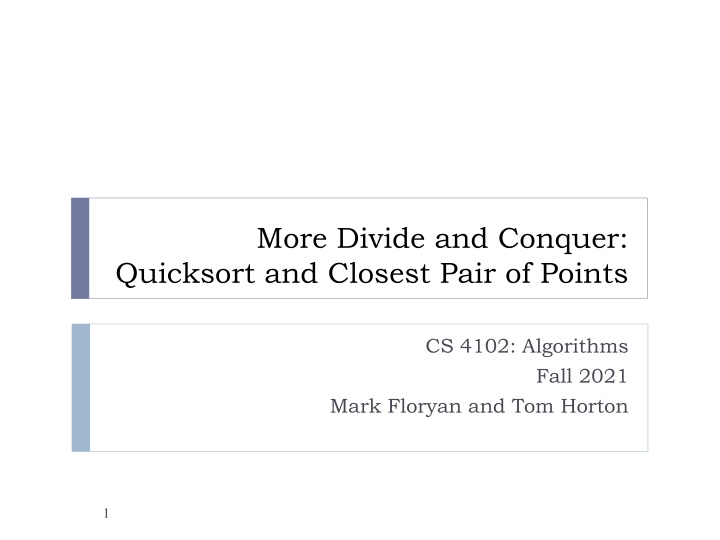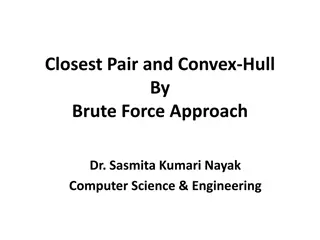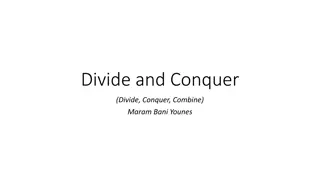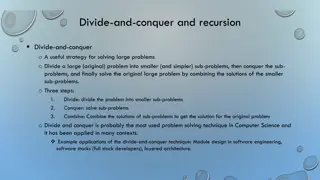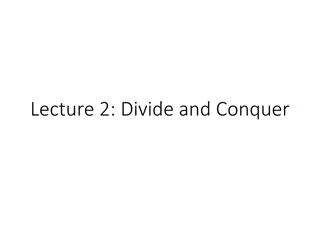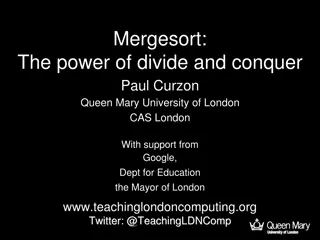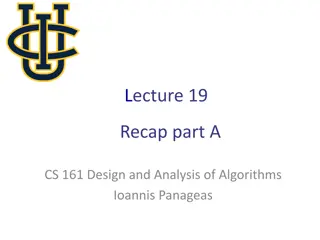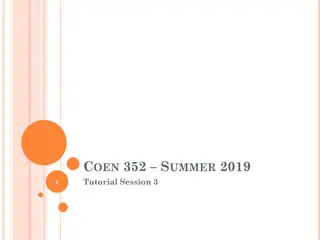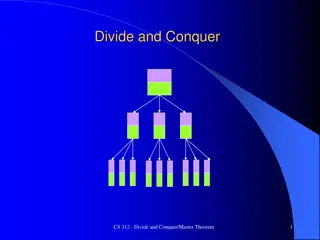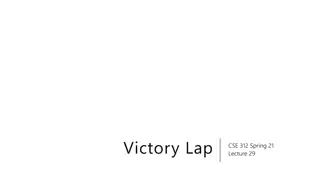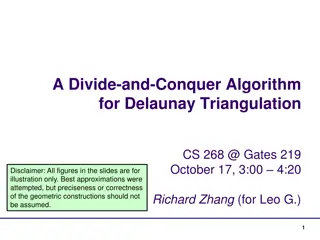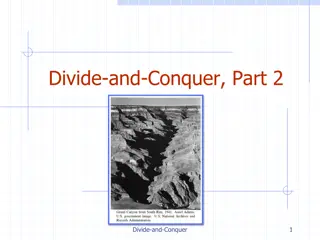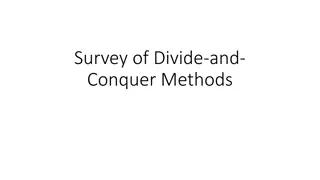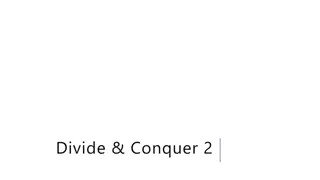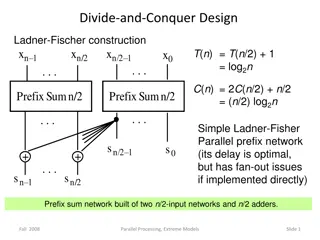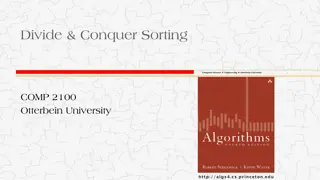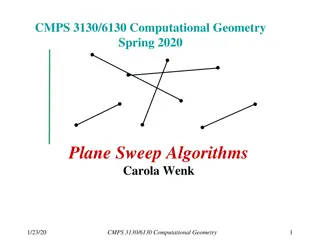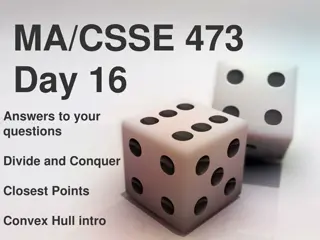Divide and Conquer: Quicksort and Closest Pair of Points
In this informative text, learn about the concepts of Quicksort and tackling the Closest Pair of Points problem using the divide and conquer strategy. The content delves into Trominoes, tromino tiling problems, and strategies for solving them with the Divide and Conquer approach.
Download Presentation

Please find below an Image/Link to download the presentation.
The content on the website is provided AS IS for your information and personal use only. It may not be sold, licensed, or shared on other websites without obtaining consent from the author.If you encounter any issues during the download, it is possible that the publisher has removed the file from their server.
You are allowed to download the files provided on this website for personal or commercial use, subject to the condition that they are used lawfully. All files are the property of their respective owners.
The content on the website is provided AS IS for your information and personal use only. It may not be sold, licensed, or shared on other websites without obtaining consent from the author.
E N D
Presentation Transcript
More Divide and Conquer: Quicksort and Closest Pair of Points CS 4102: Algorithms Fall 2021 Mark Floryan and Tom Horton 1
Next Example: Trominos Tiling problems For us, a game: Trominos In real life: serious tiling problems regarding component layout on VLSI chips Definitions Tromino A deficient board n x n where n = 2k exactly one square missing Problem statement: Given a deficient board, tile it with trominos Exact covering, no overlap 3
Trominos: Playing the Game, Strategy Java app for Trominos: http://www3.amherst.edu/~nstarr/puzzle.html How can we approach this problem using Divide and Conquer? Small solutions: Can we solve them directly? Yes: 2 x 2 board Next larger problem: 4 x 4 board Hmm, need to divide it Four 2 x 2 boards Only one of these four has the missing square Solve it directly! What about the other three? 4
Trominos: Key to the Solution Place one tromino where three 2 x 2 boards connect You now have three 2 x 2 deficient boards Solve directly! General solution for deficient board of size n Divide into four boards Identify the smaller board that has the removed tile Place one tromino that covers the corner of the other three Now recursively process all four deficient boards Don t forget! First, check for n==2 5
Input Parameters: Input Parameters: n n, a power of 2 (the board size); , a power of 2 (the board size); the location the location L L of the missing square Output Parameters: None Output Parameters: None tile tile( (n n, ,L L) { ) { if ( if (n n == 2) { == 2) { // the board is a right tromino // the board is a right tromino T T tile with tile with T T return return } } divide the board into four divide the board into four n n/2 place one tromino as in Figure 5.1.4(b) place one tromino as in Figure 5.1.4(b) // each of the 1 // each of the 1 1 squares in this tromino 1 squares in this tromino // is considered as missing // is considered as missing let let m m1 1, ,m m2 2, ,m m3 3, ,m m4 4 be the locations of the missing squares be the locations of the missing squares tile( tile(n n/2, /2,m m1 1) ) tile( tile(n n/2, /2,m m2 2) ) tile( tile(n n/2, /2,m m3 3) ) tile( tile(n n/2, /2,m m4 4) ) } }6 of the missing square /2 n n/2 subboards /2 subboards
Trominos: Analysis What do we count? What s the basic operation? Note we place a tromino and it stays put No loops or conditionals other than placing a tile Assume placing or drawing a tromino is constant Assume that finding which subproblem has the missing tile is constant Conclusion: we can just count how many trominos are placed How many fit on a n x n board? (n2 1) / 3 Do you think this optimal? 7
Trominos: Analysis Runtime? If n is the size of one board dimension (nxn board) 4 subproblems of size n/2 x n/2 O(1) to place one tromino across the cuts and combine T(n) = 4T(n/2) + 1 = ?? Also, think intuitively. There are n^2 board spaces and each round you are placing one tromino (3 spaces) So at least n^2 / 3 JUST to place the Trominos 8
Closest Pair of Points Readings: CLRS 33.4 9
Closest Pair of Points in 2D Space Given: A list of points 2 1 5 Return: Distance of the pair of points that are closest together (or possibly the pair too) 4 6 7 3 8 10
Closest Pair of Points: Nave Given: A list of points 2 1 5 Return: Distance of the closest pair of points 4 6 ?(?2) Naive Algorithm: Test every pair of points, return the closest. 7 3 8 We can do better! (?log?) 11
Closest Pair of Points: D&C Divide: How? At median x coordinate 2 1 5 Conquer: 4 6 Combine: 7 3 8 12
Closest Pair of Points: D&C Divide: At median x coordinate 2 1 5 Conquer: Recursively find closest pairs from Left and Right 4 6 7 Combine: 3 8 LeftPoints RightPoints 13
Closest Pair of Points: D&C Divide: At median x coordinate 2 1 5 Conquer: Recursively find closest pairs from Left and Right 4 6 7 Combine: Return min of Left and Right pairs Problem ? 3 8 ? LeftPoints RightPoints 14
Closest Pair of Points: D&C Combine: 2 Cases: 2 1 1. Closest Pair is completely in Left or Right 5 4 6 2. Closest Pair Spans our Cut 7 ? Need to test points across the cut 3 8 LeftPoints RightPoints 15
Spanning the Cut Define runway or strip along the cut. Combine: 2. Closest Pair Spanned our Cut Need to test points across the cut. 2 1 ?? 5 4 ?? 6 Bad approach: Compare all points within ? = min{??,??} of the cut. 7 3 How many are there? 8 2? LeftPoints RightPoints 16
Spanning the Cut Define runway or strip along the cut. Combine: 2. Closest Pair Spanned our Cut Need to test points across the cut 2 1 ?? 4 5 ?? Bad approach: Compare all points within ? = min{??,??} of the cut. 6 7 How many are there? 3 8 2? ? ? ? ? ? ? ? = ?? + RightPoints LeftPoints = ? ?? 17
Spanning the Cut Combine: 2. Closest Pair Spanned our Cut Need to test points across the cut 2 1 ?? 4 5 ?? We don t need to test all pairs! 6 7 Don t need to test any points that are > ? from one another 3 8 2? LeftPoints RightPoints 18
Reducing Search Space Combine: Need to test points across the cut Claim #1: if two points are the closest pair that cross the cut, then you can surround them in a box that s 2 ? wide by ? tall. 2 ? ? Let s draw some examples. 19
Claim #1: if two points are the closest pair that cross the cut, then you can surround them in a box that s 2 ? wide by ? tall. Reducing Search Space Assume you re checking in increasing y-order, and you ve reached the first point of the closest pair. Do you have to look at all points above it to be guaranteed to find the other point and the minimum distance? 2 ? ? No! Imagine you drew a box with its bottom at point s y-coordinate. See Claim #1. Claim #2: only 8 points can be in the box. 20
Claim #1: if two points are the closest pair that cross the cut, then you can surround them in a box that s 2 ? wide by ? tall. Reducing Search Space Assume you re checking in increasing y-order, and you ve reached the first point of the closest pair. Do you have to look at all points above it to be guaranteed to find the other point and the minimum distance? 2 ? ? No! Imagine you drew a box with its bottom at point s y-coordinate. See Claim #1. Claim #2: only 8 points can be in the box. 21
Spanning the Cut Combine: 2. Closest Pair Spanned our Cut 2 1 ?? Consider points in strip in increasing y-order. 4 5 Only check next 7 ?? For a given point p, we can prove the 8th point and beyond is more than ? from p. (pp. 1041-2 in CLRS) 6 7 3 8 2? So for each point in strip, check next 7 points in y-order. LeftPoints RightPoints ? ? ??????! 22
Closest Pair of Points: Divide and Conquer Initialization: Sort points by ?-coordinate (Later we ll also need to process points by y- coordinate, too.) 2 1 Divide: Partition points into two lists of points based on ?-coordinate (split at the median ?) 5 4 6 Conquer: Recursively compute the closest pair of points in each list Base case? 7 Combine: Consider only points in the runway (?-coordinate within distance ? of median) Process runway points by ?-coordinate Compare each point in runway to 7 points above it and save the closest pair Output closest pair among left, right, and runway points ? 3 8 LeftPoints RightPoints
Closest Pair of Points: Divide and Conquer What is the running time? (?log?) ?log? Initialization: Sort points by ?-coordinate Divide: Partition points into two lists of points based on ?-coordinate (split at the median ?) 1 Conquer: Recursively compute the closest pair of points in each list 2?(?/2) ?(?) Combine: Process runway points by ?-coordinate and Compare each point in runway to 7 points above it and save the closest pair Output closest pair among left, right, and runway points ?(?) = 2?(?/2) + (?) ? Case 2 of Master s Theorem ? ? = ?log? 1
Summary for Closest Pair of Points Comparing all pairs is a brute-force fail Except for small inputs Divide and conquer a big improvement Needed to find an efficient way for part of the combine step Geometry came through for us here! Only needed to look at constant number of points for each point in the strip Implementation subtleties Don t want to sort the strip by y-coordinate in each recursive call In initialization, create an index that lets you process all points in order by y-coordinate (There are other ways to address this.) 25
